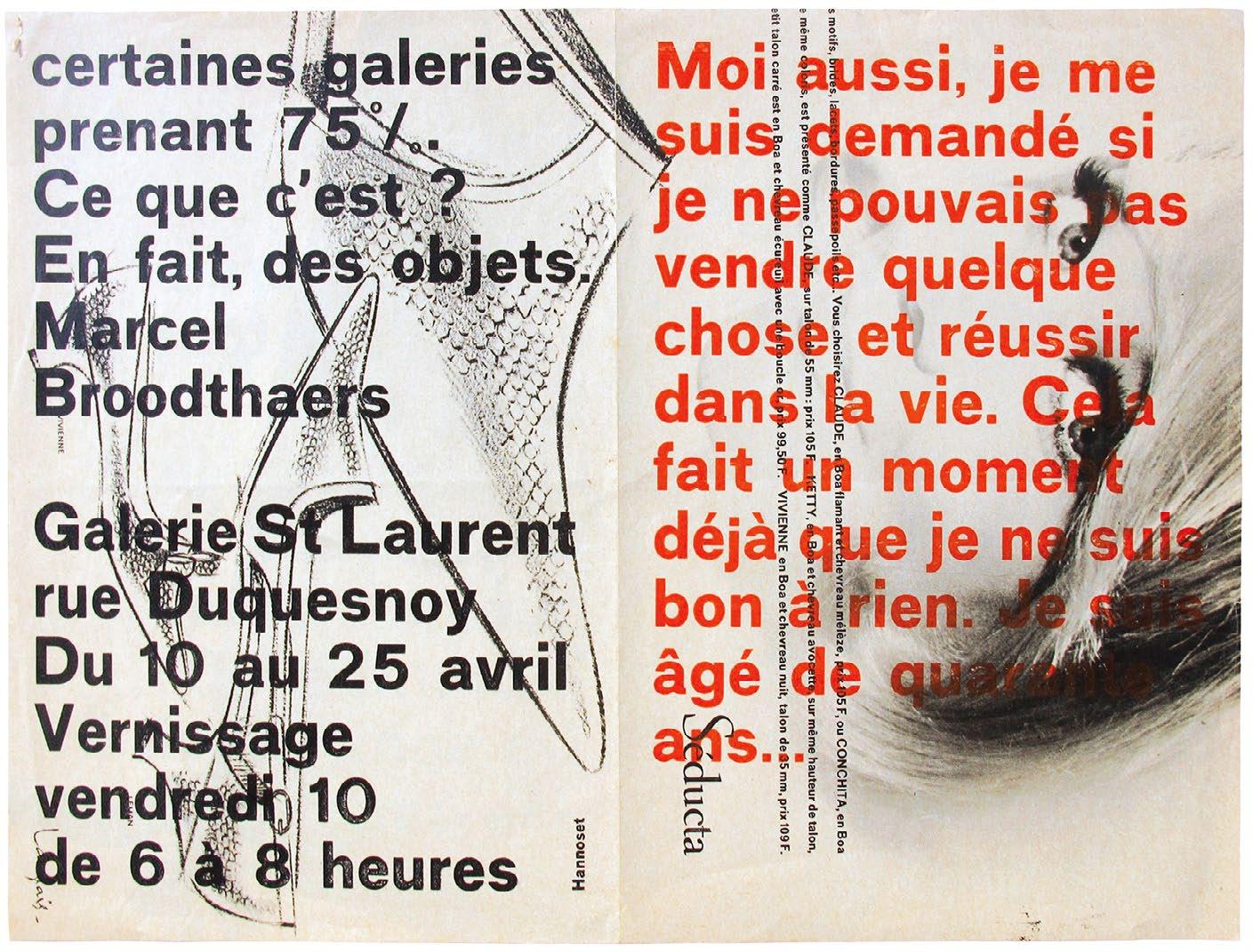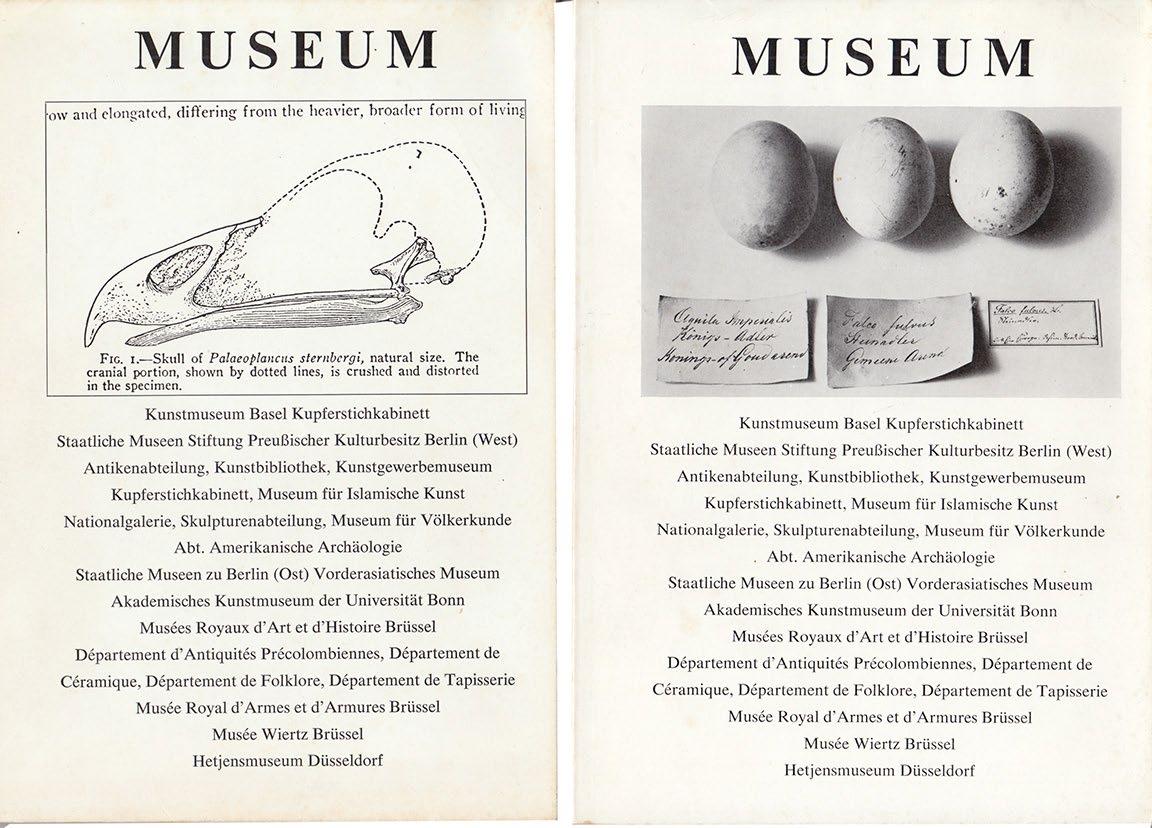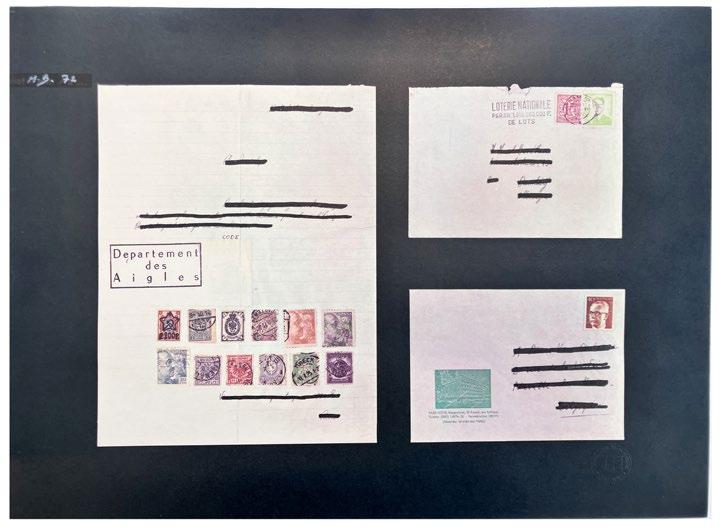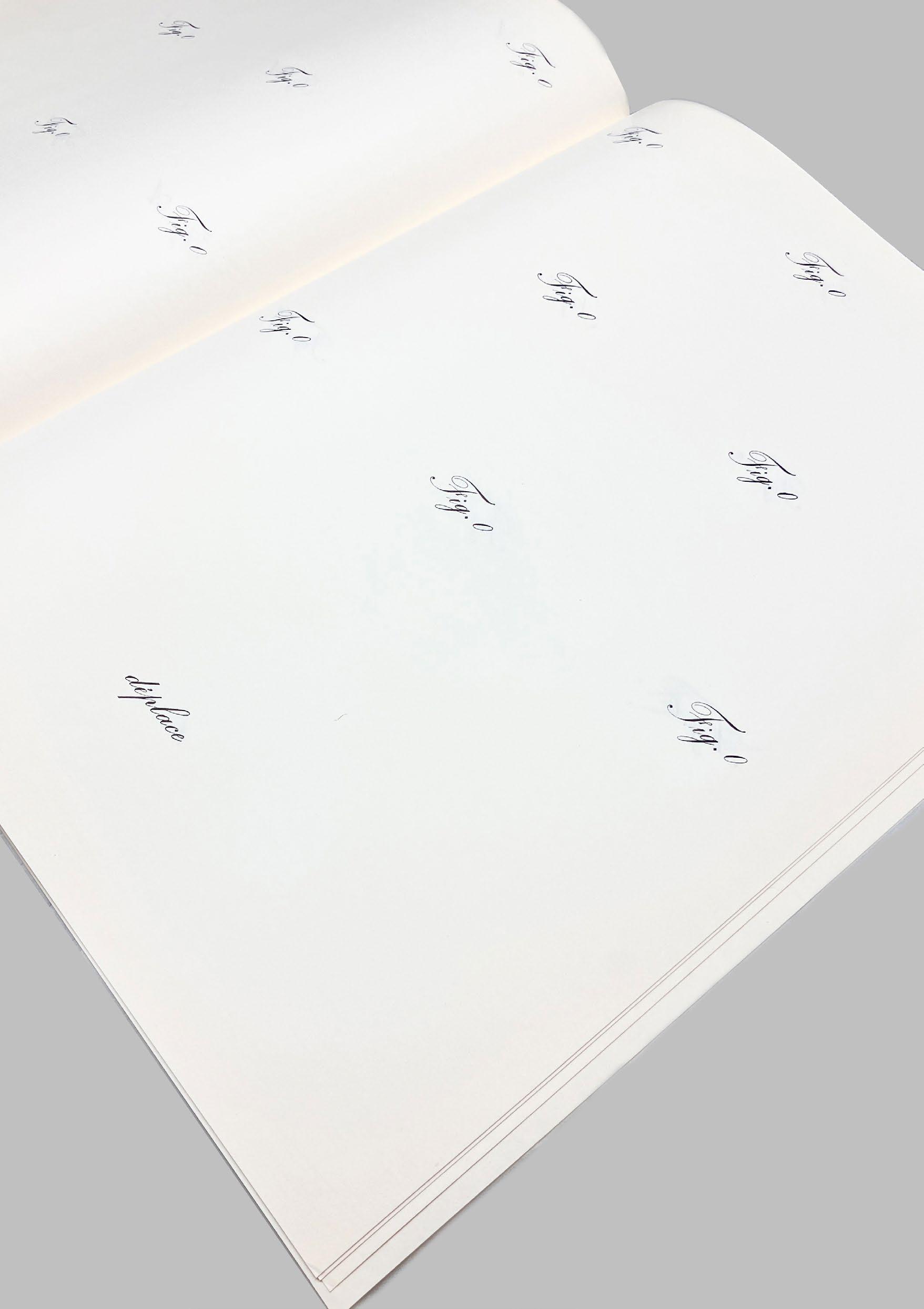marcel broodthaers

10 items
SIMS REED | JULY 2023
[01]. — The very scarce invitation / poster / announcement for Marcel Broodthaers’ first solo exhibition at Brussels’ Galerie St Laurent in 1964.
1964
Invitation to 'Moi aussi, je me suis demandé si je ne pouvais pas vendre quelque chose et réussir dans la vie … '. (I, too, wondered whether I could not sell something and succeed in life)
Single folded sheet. (252 x 338 mm). [Single magazine sheet]. Printed text in black and orange recto and verso on a page from a magazine, the text printed in landscape format over the page with printing in portrait format.
Broodthaers' exhibition at the Galerie St Laurent, rue Duquesnoy in Brussels was from 10th to 25th April, 1964; the vernissage for the exhibition was held on the 10th.
Each example of this announcement / invitation, printed using orange and black inks for the letterpress text over the page of a magazine, is necessarily unique. The present example features an advertisement for snake-skin shoes recto and the 'Miss Chantelle' girdle verso. Broodthaers' text is crucial and illuminating in regard to his transformation from Surrealist-allied poet to artist.
'Moi aussi, je me suis demandé si je ne pouvais pas vendre quelque chose et réussir dans la vie. Cela fait un moment déjà que je ne suis bon à rien. Je suis âgé de quarante ans ... [printed in orange] L'idée enfin d'inventer quelque chose d'insincère me traversa l'esprit et je me mis aussitôt au travail. Au bout de trois mois, je montrai ma production à Ph. Edouard Toussaint la propriétaire de la galerie Saint Laurent. Mais c'est de l'Art, dit-il et j'exposerais volontier tout ça. D'accord lui répondis-je. Si je vends quelque chose il prendra 30%, Ce sont, paraît-il des conditions normales certaines galeries prenant 75%. Ce que c'est? En fait, des objets. Marcel Broothaers ... [printed in black]'.
'Although most exhibition announcements are instrumental, inviting the viewer to witness a sincere, creative presence in a white cube, Marcel Broodthaers’ first one-person exhibition poster announces a very different approach to making art and publicity (which, in Broodthaers’ 'studio' / 'museum' went hand in hand). Having been struck by the developments of American Pop art in Paris in 1963-64, Broodthaers’ announced his transformation from poet to artist after hitting upon 'the idea of inventing something insincere'; tellingly, this first announcement / manifesto is printed on different pages removed from a Belgian fashion magazine. It is difficult to say that this collision of image-and-text - this 1964 exhibition announcement - is less consequential than just about anything else the artist produced during his first year at work.' (Todd Alden).
£9,500
Brussels
Galerie St Laurent


[01].
[02]. — The scarce catalogue for Broodthaers’ first major solo exhibition.
Antwerp
Wide White Space Gallery
1966
Moules / Oeufs / Frites / Pots / Charbon
8vo. (200 x 138 mm). [3 bifolia including wrappers]. Title and exhibition details to front wrapper with brief artistic biography of Broodthaers' verso, blank leaf, leaf with reproduction of Broodthaers' manuscript recto and 'Ma Rhetorique (Moule)' verso, leaf with 'Poème (Oeuf)' recto and 'Théorèmes (Frites)' verso, blank leaf, inner rear wrapper with publication history and texts on Broodthaer's work and rear wrapper with advertisement for the gallery; illustrated with reproduction of Broodthaers' manuscript and three monochrome illustrations. Original publisher's white stapled printed wrappers with titles and text in black.
Held at Antwerp's Wide White Space Gallery from 26th May - 26th June, 1966 (with the vernissage held on 26th May), Marcel Broodthaers' exhibition 'Moules Oeufs Frites Pots Charbon' was a typically poetic artistic exercise and the catalogue presented here, for the same exhibition, is no different. Although the catalogue incorporates standard biographical texts and timelines - it includes texts by Jean Deypreau ('A Fleur de Pot') and Pierre Restany ('Quand la Vie Devient Objet') - it works also as an artist book, featuring a reproduction of Broodthaer's repetitive inscription of several of the words of the title - he omits 'charbon' but includes 'coeur' - and three of his illustrated poem works: 'Ma Rhétorique (Moule)', 'Poème (Oeuf)' and 'Théorèmes (Frites)'. Each of these poem works is typically playful and typically gnomic incorporating absurdist repetitive text, word substitution, satirical aphorism and counterintuitive illustration.

'La pipe de Magritte est le moule de la fumée.' (From Broodthaers' text).
The catalogue is scarce and OCLC locates copies at the National Gallery of Art, Washington, the Bibliothèque Kandinsky, Paris, the Kunstbibliothek of the Staatliche Museen, Berlin and the Vlaamse Erfgoedbibliotheek only; COPAC locates only a copy of the 1974 reprint in the UK.
£1,250
Un Coup de Dés Jamais N’Abolira le Hasard - Image Antwerp / Cologne
Wide White Space Gallery / Galerie Michael Werner 1969
Folio. (326 x 250 mm). [16 unnumbered leaves, blanks included]. Leaf with Broodthaers' title, leaf with 'Préface' signed by Stéphane Mallarmé (a transcription in toto of Mallarmé's original verse replacing Mallarmé's original prefatory text), blank leaf, leaf with title cancelled with black line and 10 leaves with Mallarmé's verse with each line cancelled in black, final verso with 'Imprimé en Belgique' and final leaf with justification and copyright recto. Original publisher's white printed wrappers with titles in red and black to front cover within rules of black and red, printed 'exemplaire catalogue' to rear cover, original glassine dust-jacket as issued.
From the edition limited to 400 copies, with this one of 300 marked 'exemplaire catalogue' on white wove paper without watermark, inscribed by Broodthaers in blue ink, signed with his initials 'M. B.' (as usual) and dated 'déc. 69.'; the copies marked 'exemplaire catalogue' were not issued with a signature or number.
Broodthaers' inscription replaces his own name (he has crossed through it with a large 'X') in 'Copyright 1969 by Marcel Broodthaers Bruxelles' with an arrow from the 'by' to the new names 'Olga et Sandro', while beneath he has dated and signed it: 'déc. 69. / M. B.'
Olga Morano (1935 - 1999) was a Paris-based conceptual artist, painter and sculptor. A close friend of Broodthaers and other Belgian artists such as Marcel Mariën, she owned a number of artist books by Broodthaers that included presentations. The present book, Broodthaers' appropriation of Mallarmé, with its presentation to 'Olga et Sandro' becomes Broodthaers' gift of his appropriation of Mallarmé: i.e. the appropriation of Mallarmé by 'Olga et Sandro', a further irony in the conceptual labyrinth of mirror images the book presents and represents.
'It seemed to me that I was looking at the form and pattern of a thought, placed for the first time in finite space. Here space itself truly spoke, dreamed, and gave birth to temporal forms.' (Paul Valéry on Mallarmé's 'Un Coup de Dés Jamais N'Abolira le Hasard: Poème').
In 1914, Stéphane Mallarmé’s ambitious typographical construction, the extraordinary poem, 'Un Coup de Dés Jamais N’Abolira le Hasard: Poème', was finally published - in the form that Mallarmé had himself envisaged - by Gallimard's 'Editions de la Nouvelle Revue Française'. A version had appeared during Mallarmé's lifetime, in 1897, in 'La Revue Cosmopolis' but the title aside, Mallarmé's vision for the poem - refused by printers at the time as unfeasible and absurd - was ignored. The original edition of 1914, seen through the press by Mallarmé's son-in-law, was printed as a limited edition in Belgium in 1,000 copies, 100 large paper examples and 900 ordinary copies (the ordinary copies unmentioned on the justification). The poem itself is a typographical caprice and a visual object of linguistic power that preceded Apollinaire's calligrammes by more than a decade. In Mallarmé's own words, taken from his introductory 'Préface': 'les «blancs» en effet, assument l’importance, frappent d’abord ; la versification ... occupe, au milieu, le tiers environ du feuillet … '.
[03].
— An excellent, crisp presentation copy of Marcel Broodthaers’ important appropriation of Stéphane Mallarmé.
In 1969, Marcel Broodthaers took Mallarmé’s assertion at face value, and presented his own version of the poem. The covers in Broodthaers' artist book replicate almost exactly those of the 1914 edition albeit with three specific modifications: the replacement of Mallarmé's name with that of Broodthaers, Mallarmé's 'Poème' has become Broodthaers' 'Image', and the location and name of the original publisher has been replaced with those of the later edition, Brussels and Cologne in place of Paris, and Wide White Space and Galerie Michael Werner in place of Gallimard's 'N R F' (Nouvelle Revue Française).

Further, Broodthaers replaced the title (it reflects the changes to the cover), the 'Préface' in Broodthaers' version is the whole text of Mallarmé's original poem (Mallarmé's own 'Préface' has been removed), the justification mirrors that of the 1914 edition (including the omission of the details of the 'édition courant' of 900 copies as is usual with a French publication) and, of most importance, Broodthaers has redacted Mallarmé's poem throughout with a series of black effacements that exactly match the typographical arrangement of the original. Broodthaers’ process transforms Mallarmé’s 'Poème' into 'Image', from poetry to graphic, into a pure abstraction, a book without text.
'After a two-decade 'obsession' with Stéphane Mallarmé's seminal modernist poem of the same title, to which fellow Belgian René Magritte had introduced him, Broodthaers finally decided it was time to 'redo the roll of the dice'. Using the 1914 Gallimard edition of Mallarmé's 1897 work, he covered over his fellow poet's words - so carefully arranged on the page... '. (Artist Who Make Books).
[Ceuleers 33; Jamar 32; Werner 8; Artists Who Make Books, pp. 50 - 51].
£12,500


Düsseldorf
Alfried Holle for Städtische
Kunsthalle Düsseldorf
1972
8vo. 2 vols. (210 x 148 mm). pp. 64; 64. Title, monochrome frontispiece and list of contents to each vol., printed text in German and monchrome and colour illustration throughout. Original publisher's white printed glossy wrappers with text and illustration in black.
Museum. Der Adler vom Oligozän bis heute. Zeigt eine experimentelle Ausstellung seines Musée d'Art Moderne, Département des Aigles, Section des Figures
Broodthaers' exhibition was held in the Städtische Kunsthalle Düsseldorf from 16th May - 9th July, 1972. Designed by the artist himself, the extensive catalogue contains entries and statements by the artist, together with a detailed catalogue of works, an encyclopedia (A - M in vol. I, M - Z in vol. II), bibliography and extensive illustration; unsurprisingly given Broodthaers' title, 'Der Adler vom Oligozän bis heute' (The eagle from the Oligocene [era] to today) the images are dominated by that of the eagle. The Oligocene was a geological epoch beginning approximately 34 million years ago although the eagle as a genus ('aquila') appears to have evolved in a later era, the Miocene.
£300

[04]. — The catalogue for Broodthaers' exhibition at the Städtische Kunsthalle Düsseldorf designed entirely by the artist.
[05]. — Broodthaers’ ‘Lettre Ouverte’ print depicting the envelopes and letter for a ‘Lettre Ouverte’ with cancelled text.
Folio. (380 x 515 mm). Sheet of thick wove paper with colour offset print by Marcel Broodthaers recto only, initialled and dated in white crayon at upper left and with the publisher's blindstamp at lower right.
Lettre Ouverte. (Version Définitive)
From the edition limited to 300 unnumbered copies initialled 'M. B.' and dated '72' in white crayon at upper left and with the blindstamp of the publisher with the text 'RIJKSCENTRUM FRANS MASEREEL KASTERLEE' at lower right; a proof version was also issued.

Marcel Broodthaers composed a series of what he termed 'Lettres Ouvertes' (open letters) issued from his 'Departement des Aigles' which he then sent to members of the art-world. Many of the letters were published subsequently in small editions as printed texts, or, as here, had the text cancelled and made into an original image. The letters often comment on the social context of art of the period or allude to the weather, flowers, gardens and more ephemeral and traditionally Romantic themes. The ironical and ambiguous use of a confidential tone, the power of Broodthaer's one-man movement, the use of an 'old-fashioned' instrument such as an open letter in a world so fond of 'new media', are all typical of Broodthaers' critical interventions in the often self-involved and self-conscious world of art.
The proof version of this 'Lettre Ouverte' features uncancelled text and shows that the envelope at upper right features Broodthaers' own address, while that at lower right is addressed to Pierre Van Osselaere. The actual letter, dated 'le 6 Juin 1972' and addressed to 'Cher Masereel' reads as follows: 'Le ciel est dégagé ce jour ... les nuages / sont devenus plus rares et je vois des oiseaux poindre à l'horizon ... / il n'est peut-être qu'un cauchemar. / Vivions-nous un printemps en 1972?'
[Ceuleers 13a]. £4,000
Kasterlee Rjkscentrum Frans Masereel. 1972
(Brussels)
1972
presentation from the artist.
Small 8vo. (152 x 108 mm). Magic slate of pale green card with metal reinforcement to edges, window cut to front with celluloid panel showing the magic slate, ink inscription verso. Loose as issued in original (?) envelope, later card protective box.
L'Ardoise Magique ou la Signature de l'Artiste
The pale green card backing of the slate is inscribed by Marcel Broodthaers in a darker green ink: '"L' Ardoise Magique, / ou / "La Signature de L'Artiste, / 30 Octobre 72 / A. Françoise Lambert, / MB.'
The artist's widow, Maria Gilissen, has stated that Broodthaers' created some 18 different 'magic slates' in various sizes, combinations and formats, however very few examples were inscribed and presented by him. This example features Broodthaers' signature, his initials, multiple times to the re-usable surface as well as to the verso of the card enclosure where the work is titled, dated and presented. Françoise Lambert, to whom the work was presented, was the owner of the eponymous Galleria Françoise Lambert in Milan, where Broodthaers (and others of the so-called 'neo-avant-garde' such as Buren) held a number of exhibitions.
Sigmund Freud thought the magic slate or writing slate (in French 'ardoise magique' or 'Wunderblock' in German) analogous to the human system of perception and its links to the unconscious - his 1924 essay 'Notiz über den 'Wunderblock'' outlines his theory - and it seems likely that Broodthaers, like Freud, was intrigued by the magic slate's capacity to retain detail even if that detail has been erased by the action of the slate's 'magic' and is no longer visible.
'L'ardoise magique repose sur le principe suivant : toute inscription est effacée simplement en tirant sur la plaquette médiane. Elle reste cependant gravée, invisible, sur une pellicule à l'intérieur de l'appareil. / Die Schreibtafel beruht auf dem folgenden Prinzip : jede Beschriftung wird durch einfachen Herauszichen der Tafel ausgelöscht. Sie bleibe über unsichtbar auf einen Film in Innern der Vorrichtung graviert. / The writing slate is based on the following principle : each inscription can be wiped off just by pulling out the plate. Yet it remains invisibly engraved on a film inside the device.' (From Marcel Broodthaers' 'Magie').
[06].
— A wonderful example of a unique Broodthaers magic slate: ‘L’ Ardoise Magique ou La Signature de l’Artiste’ with a
' ... this is precisely the way in which, according to the hypothesis I mentioned just now, our mental apparatus performs its perceptual function. The layer which receives the stimuli - the Pcpt.-Cs. [Perception-Consciousness] - forms no permanent traces; the foundations of memory come about in other, adjoining, systems ... I do not think it is too far-fetched to compare the celluloid and waxed paper cover with the system 'Pcpt.-Cs.' and its protective shield, the wax slab with the unconscious behind them, and the appearance and disappearance of the writing with the flickering-up and passing-away of consciousness in the process of perception.' (Sigmund Freud translated by James Strachey).
£17,500


[07].
—
An excellent, pristine example of the Marcel Broodthaers art & project bulletin / exhibition.
Amsterdam
art & project
1973
Art & Project Bulletin No. 66: Marcel Broodthaers
From the edition limited to 800 copies.
Bulletin No. 66 is titled 'marcel broothaers rétrospective (octobre 1963 - mars 1973)'. The publication itself was the exhibition.

Single folded sheet. (295 x 210 mm). Single bifolium].
Printed text in French with 18 works by Broodthaers reproduced in black and white.
This copy never folded or mailed and therefore in an excellent, pristine state of preservation.
'chaque objet, répresenté ici, prend sa place dans ses séries correspondant à des themes 'la signature de l'artiste’, 'la toile photographique', 'l'objet comique’, 'l'objet absent’, 'la peinture’, 'le cinema...' (From the cover).
£950

Small folio. (320 x 250 mm). [8 unnumbered leaves]. Leaf with half-title ('Fig. 1 / Fig. 2 / Fig. 0 / Fig. 1 2 / Fig. A'), leaf with Baudelaire's sonnet 'La Beauté' printed in black with a single line printed in red (the title of the present work) and headline '(Fig. 1)', verso and following 4 leaves each with a single word from the same line at foot of page in black and typographical variations of the half-title, leaf with with Baudelaire's sonnet 'La Beauté' repeated in black with 'les étoiles' printed in red and headline '(Fig. 2)' recto, justification verso with headline '(Fig. 0)', leaf with quotation by Broodthaers' recto with headline '(Fig. 12)'. Original publisher's white printed wrappers with titles in red and black to front cover and (Fig. A) in black to rear.
Charles Baudelaire. Je Hais le Mouvement Qui Déplace les Lignes
From the edition limited to 338 copies, with this one of 3 lettered copies, inscribed 'A' and initialled 'M B', on papier Roemerturm Alt Xanten à la cuve conforming to the édition de tête signed and numbered by Broodthaers in ink; the remaining copies, on different paper, were neither signed nor numbered.
Broodthaers, in signature playful style, designated the édition de tête of thirteen copies (i.e. the three lettered and ten numbered examples he signed) as forming the true original edition ('formant authentiquement l'édition originale') of his work. The other 300 copies of the book, those he neither signed nor numbered, were designated by Broodthaers as the first edition ('première édition'); a further 25 copies were marked 'S. P' and were 'reservés à la presse'. Broodthaers hierarchy is subtle but important and characteristic of the way he presented his books.
For Broodthaers, the French poet and critic Charles Baudelaire, the historical period he occupied, and the literary figures such as Dumas and Mallarmé who preceded and followed him, was of central interest. In the winter of 1969 / 1970 Broodthaers had participated in a seminar on Baudelaire conducted by the literary sociologist Lucien Goldmann, a symposium that had a profound impact on the artist. In the five years that followed, Baudelaire would provide the inspiration for several of Broodthaers’s works: in 1970, he made a seven-minute film called 'A Film by Charles Baudelaire (Political Map of the World)', in 1972, as part of an exhibition in Paris, he produced a series of prints that included one titled 'Charles Baudelaire Paints', 1973 saw the present work, 'Je Hais le Mouvement Qui Déplace les Lignes', and the following year, 1974, Broodthaers published 'Charles Baudelaire / Pauvre Belgique', with the entirety of Baudelaire's condemnatory text - Baudelaire had detested his time in Belgium - omitted.
In 'Je Hais le Mouvement Qui Déplace les Lignes', Broodthaers takes Baudelaire's sonnet 'La Beauté' from the 'Spleen et Idéal' section of 'Les Fleurs du Mal' (1857), prints it in full on the second leaf but with line seven of the second stanza in red, that line becoming the title of the book. This page is designated at the head '(Fig. 1)' and the following eight pages each feature, at the foot, a word in sequence from that line, together with a changing typographical mise en page of 'Fig. 1', 'Fig. 2' and so on. These variations concluded, Baudelaire's sonnet is reprinted, but with the original red line now in black and 'les
[08].
Hamburg Edition Hossmann 1973
— A superb copy of the édition de tête of the ‘édition originale’ of Broodthaers’ anonymous artist book inspired by Baudelaire’s sonnet ‘La Beauté’: the first of 3 lettered copies and one of only 13 signed by the artist.
étoiles' in the penultimate line of the ultimate stanza in red. This page is designated '(Fig. 2)' while the following page, with the justification, is designated '(Fig. 0)' and the final page with Broodthaers' own quotation is assigned '(Fig. 12)'; the final flourish is the rear cover - the front cover makes no mention of Broodthaers but only Baudelaire - which is marked '(Fig. A)'. All of the brackets for the 'figure' designations are Broodthaers' own.
With these 'figures' established, the typographic variation in the mise en page with the words from the original red line takes on significance and establishes an ongoing interplay between the poem and words of Baudelaire, the line 'Je hais le mouvement qui déplace les lignes' and the words 'les étoiles' in particular, the thoughts of Broodthaers concerning Baudelaire, as well as the artist book as a work - that red line becoming the title of the work - and as an object. It is worth noting that Broodthaers as the author of this work is uncredited (the book is more of an imaginary or ersatz book by Baudelaire), the cover making no reference to him, and his name features only on the page '(Fig. 12)' with his own quotation. In that quotation (see below) Broodthaers stresses that he took part in Goldman's seminar as 'artiste', that word printed in italics.

In 1971, in a similar fashion to the subsequent 'Je Hais le Mouvement Qui Déplace les Lignes', Broodthaers produced a Mönchengladbach Kassettenkataloge consisting of a series of matryoshka-like boxes designated 'Fig. 1', 'Fig. 2', 'Fig. 0' and 'Fig 12'. A text by Johannes Cladders to the underside of each of the boxes is designated 'Fig. A' and serves as a key or rubric to the catalogue multiple. The figures in the present artist book work in a similar way, ‘(Fig. A)' in particular, and it is worth quoting a detail from the Mönchengladbach text, a quotation in German by Broodthaers that in a sense unlocks the works: 'Fig. A bezeichnet meine Mitarbeit am Text, bevor ich ihn gelesen habe.'
'Ce livre trouve son origine dans un séminaire de Lucien / Goldmann sur Baudelaire, tenu à Bruxelles l'hiver / 1969 - 1970, auquel j'avais été invité à participer comme 'artiste'.' / MARCEL BROODTHAERS'. (Broodthaers' text on the final leaf).
[Ceuleers 39; Jamar 38; Werner 15]. £17,500




[09]. — An excellent example of the rare catalogue plus poster for Broodthaers’ 1974 exhibition.
Brussels
Société des Expositions du Palais des Beaux-Arts 1974
Small folio. Poster: (873 x 630 mm, unfolded). pp. 75. Illustrated in colour and monochrome throughout; with poster consisting of the same images as used in the catalogue. Original publisher's white printed wrappers with titles to front cover in black.
Catalogue - Catalogus

This catalogue is complete with the large colour offset-printed poster (630 x 870 mm) which was designed to be offered together with the catalogue, but is often missing. As Broodthaers states on the front cover text: ‘Ce catalogue non signé et non numéroté ne peut être considéré séparément de la planche où les mêmes images sont présentés dans un contexte de lecture différent.’ (This unsigned and unnumbered catalogue cannot be considered separately from the poster where the same images are presented in a different context). The same text is repeated on the rear (Flemish) cover with the text in Flemish.
£1,250


























